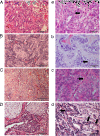Gene expression profiles in canine mammary carcinomas of various grades of malignancy
- PMID: 23587192
- PMCID: PMC3691656
- DOI: 10.1186/1746-6148-9-78
Gene expression profiles in canine mammary carcinomas of various grades of malignancy
Abstract
Background: The frequency of mammary malignancies in canine patients is even three times over than in human. In various types of cancer different intracellular signalling pathways are perturbed, thus the patients with pathologically the same type of cancer often have dissimilar genetic defects in their tumours and respond in a heterogeneous manner to anticancer treatment. That is why the objective of the hereby study was to assess the gene expression profiles in canine mammary carcinomas (in unsupervised manner) classified by pathologists as grade 1 (well differentiated), grade 2 (moderately differentiated) and grade 3 (poorly differentiated) and compare their molecular and pathological classifications.
Results: Our unsupervised analysis classified the examined tissues into three groups. The first one significantly differed from the others and consisted of four carcinomas of grade 3 and one carcinoma of grade 2. The second group consisted of four grade 1 carcinomas. The very heterogeneous (based on their pathological parameters) group was the last one which consisted of two grade 1 carcinomas, two grade 3 carcinomas and five grade 2 carcinomas. Hierarchical dendrogram showed that the most malignant tumour group had significantly distinct gene expression.
Conclusions: Molecular classification of canine mammary tumours is not identical with pathological classification. In our opinion molecular and pathological characterization of canine mammary malignancy can complement one another. However, furthers studies in this field are required.
Figures



References
-
- Misdorp W, Else RW, Hellmen E, Lipscomb. Histological Classification of Mammary Tumors of the Dog and the Cat, Volume 7. Washington, D.C, USA: Armed Forces Institute of Pathology and the American Registry of Pathology and The World Health Organization Collaborating Center for Worldwide Reference on Comparative Oncology; 1999. pp. 11–29.
-
- Pena L, Andres De PJ, Clemente M, Cuesta P, Perez-Alenza M. Prognostic value of histological grading in noninflammatory canine mammary carcinomas in a prospective study with two-year follow-up. Relationship with clinical and histological characteristics. Vet Pathol. 2013;50(1):94–105. doi: 10.1177/0300985812447830. - DOI - PubMed
Publication types
MeSH terms
Associated data
- Actions
LinkOut - more resources
Full Text Sources
Other Literature Sources
Molecular Biology Databases

